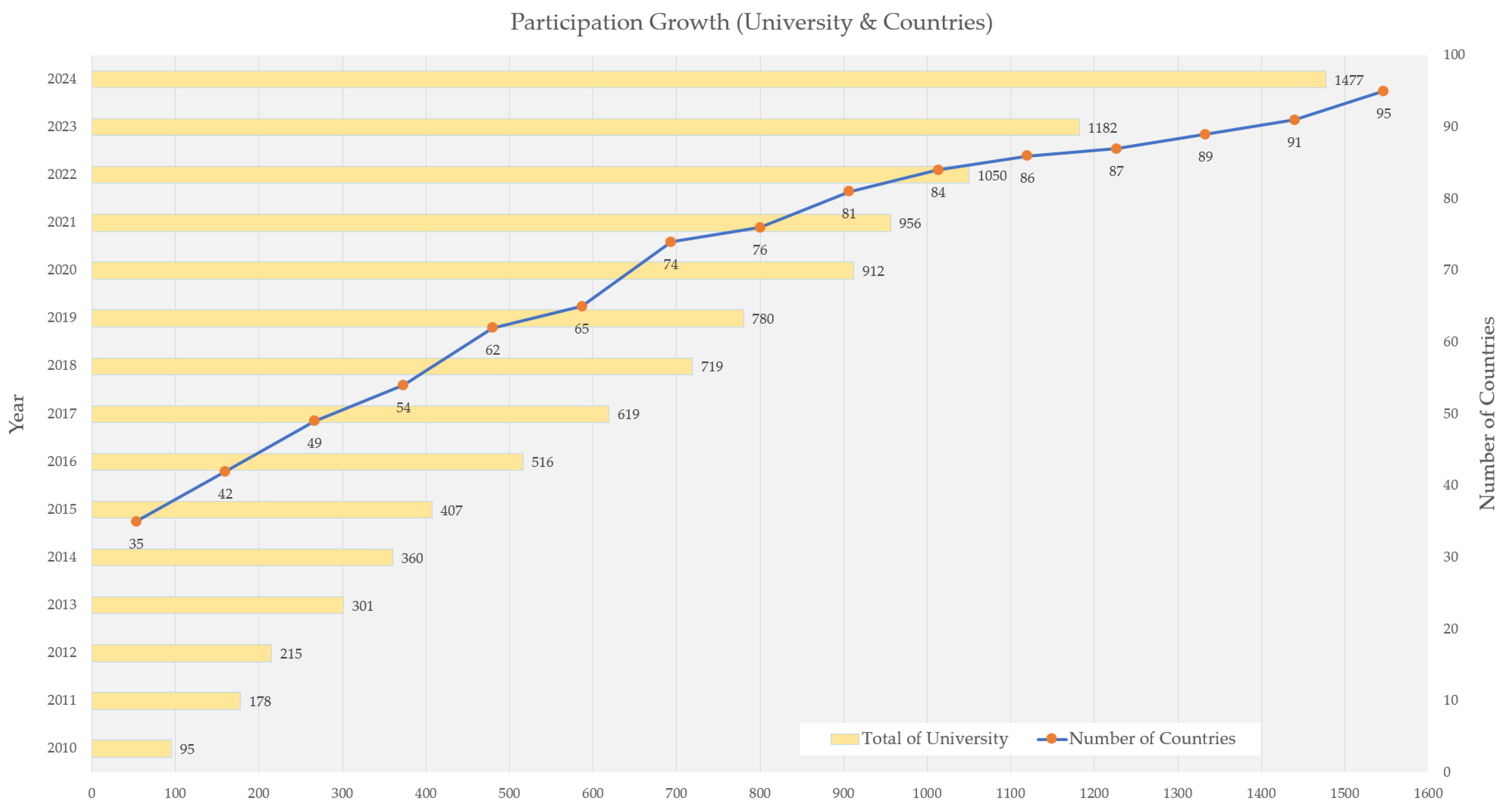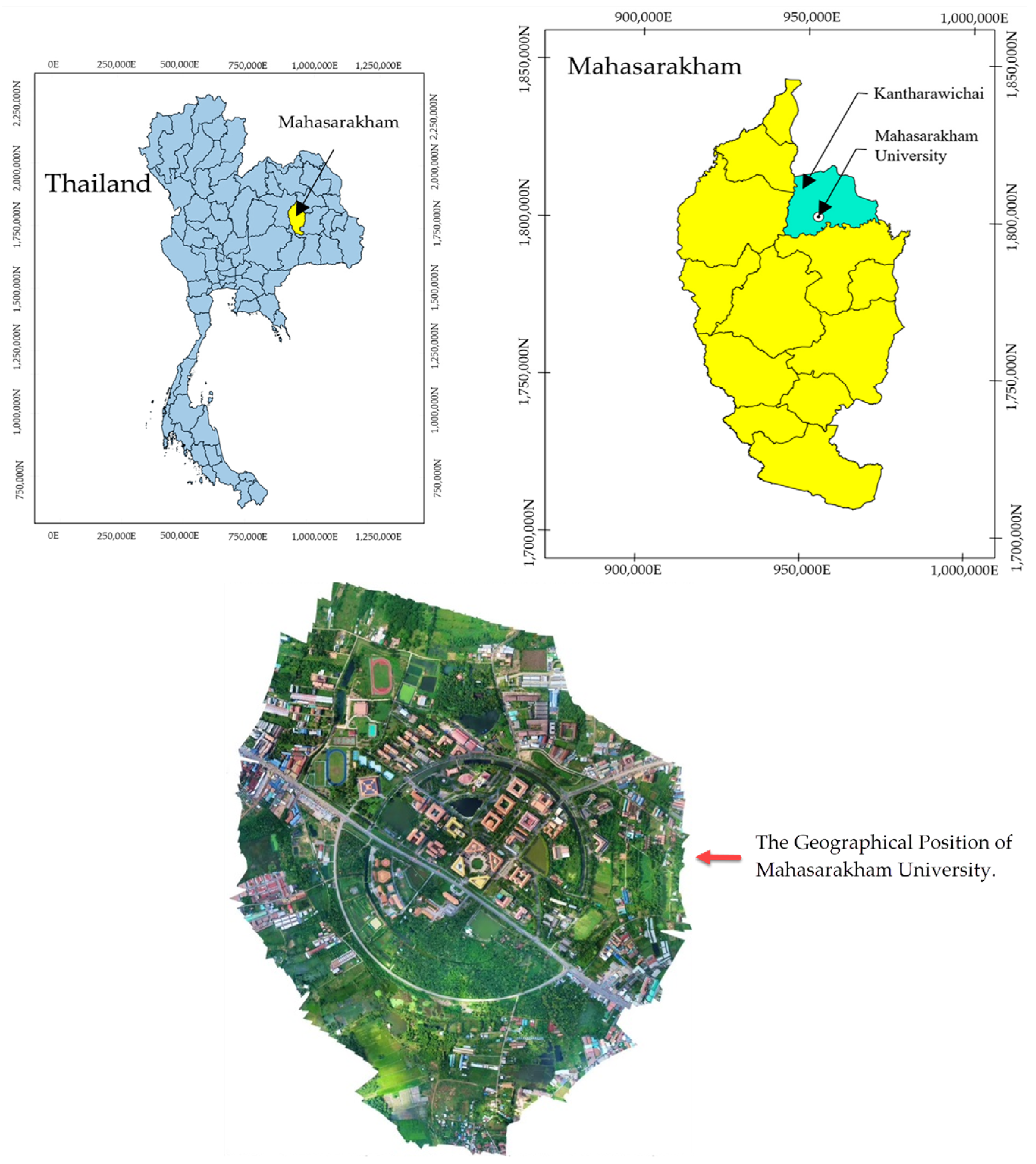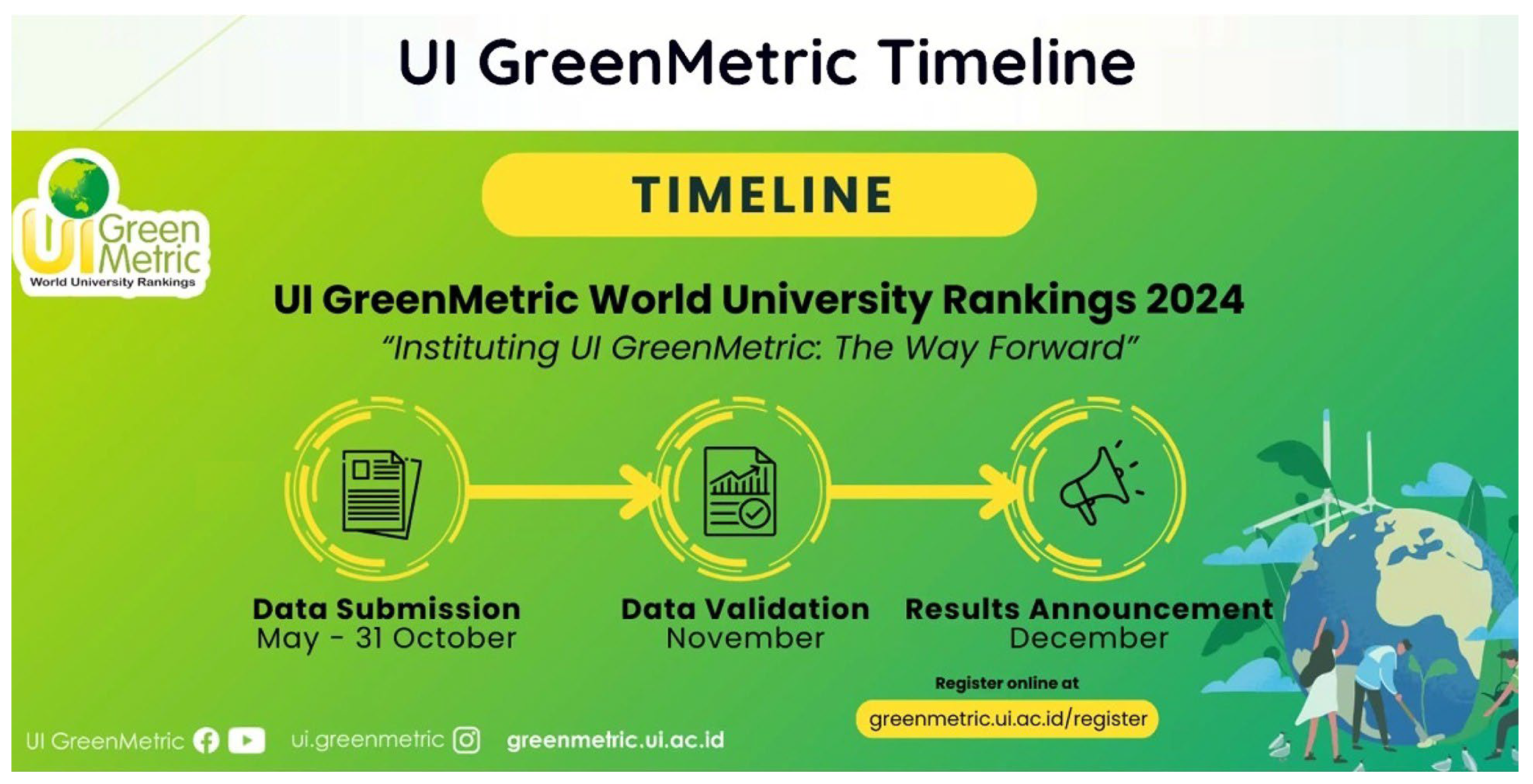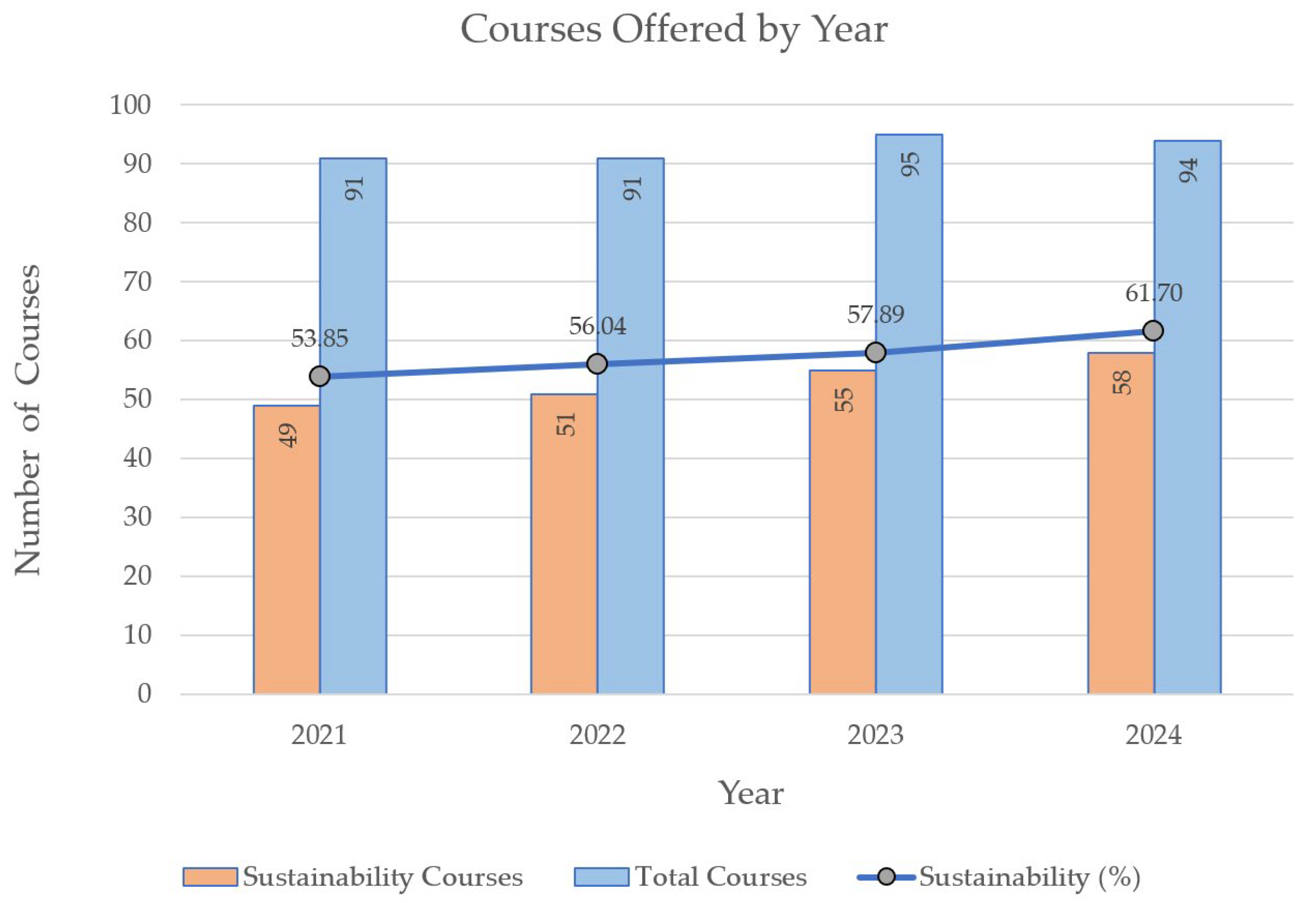Sustainability in Action: Analyzing Mahasarakham University’s Integration of SDGs in Education, Research, and Operations
Abstract
1. Introduction
2. Materials and Methods
2.1. Research Area
2.2. Methodology
2.2.1. Criteria
2.2.2. Scoring
2.2.3. Data Sources, Instruments, Validation, and Analysis
- Scorei is the final weighted score for indicator i (units: points);
- Observedi is the empirically observed value for indicator i (number of sustainability-related courses);
- Benchmarki is the benchmark or full-score target defined by GreenMetric for indicator i;
- Weighti is the maximum weight (points) assigned to indicator i in the ED table.
2.3. Educational and Research Operations
2.3.1. Plan
2.3.2. Do
2.3.3. Check
2.3.4. Action
2.4. Data Preparation for Submission to the Designated System
2.4.1. Data Preparation
2.4.2. Integration of Data Submission Systems
3. Results and Discussion
Analysis of Key Performance Indicators
- Total Number of Sustainable Curriculum Offerings.
- 2.
- Research Financing Associated with Sustainable Research Initiatives.
- 3.
- Number of Sustainable Publications.
- 4.
- Number of Sustainable Community Service Initiatives and/or Engaged Students
- 5.
- Conclusion on Mahasarakham University’s Global Ranking Performance
4. Conclusions
Author Contributions
Funding
Institutional Review Board Statement
Informed Consent Statement
Data Availability Statement
Acknowledgments
Conflicts of Interest
References
- Liu, J.-X. The Influence of Narrative Transportation on University Students’ Environmental Intentions: A Serial Mediation of Empathy with Nature and Environmental Attitudes. J. Clean. Prod. 2023, 431, 139763. [Google Scholar] [CrossRef]
- Jiang, Q.; Kurnitski, J. Performance Based Core Sustainability Metrics for University Campuses Developing towards Climate Neutrality: A Robust PICSOU Framework. Sustain. Cities. Soc. 2023, 97, 104723. [Google Scholar] [CrossRef]
- Schiavon, M.; Ragazzi, M.; Magaril, E.; Chashchin, M.; Karaeva, A.; Torretta, V.; Rada, E.C. Planning sustainability in higher education: Three case studies. WIT Trans. Ecol. Environ. 2021, 253, 99–110. [Google Scholar] [CrossRef]
- Atici, K.B.; Yasayacak, G.; Yildiz, Y.; Ulucan, A. Green University and Academic Performance: An Empirical Study on UI GreenMetric and World University Rankings. J. Clean. Prod. 2021, 291, 125289. [Google Scholar] [CrossRef]
- Grigorescu, A.; Munteanu, I.; Dumitrica, C.D.; Lincaru, C. Development of a Green Competency Matrix Based on Civil Servants’ Perception of Sustainable Development Expertise. Sustainability 2023, 15, 13913. [Google Scholar] [CrossRef]
- Perchinunno, P.; Cazzolle, M. A Clustering Approach for Classifying Universities in a World Sustainability Ranking. Environ. Impact. Assess. Rev. 2020, 85, 106471. [Google Scholar] [CrossRef]
- Yong, J.Y.; Yusliza, M.Y.; Ramayah, T.; Farooq, K.; Tanveer, M.I. Accentuating the Interconnection between Green Intellectual Capital, Green Human Resource Management and Sustainability. Benchmarking 2023, 30, 2783–2808. [Google Scholar] [CrossRef]
- Sari, R.F.; Suwartha, N.; Setiani, H.; Sidiyanto, Y.A. The Impact of UI GreenMetric Involvement on Universities’ Performance in Shaping a Sustainable Campus. J. Sustain. Perspect. 2023, 3, 399–414. [Google Scholar] [CrossRef]
- Romero-Infante, J.A.; Ramírez, M.S.R.; Luna, L.A.; Leguizamon, S.; Verjel, E. Green Economy Metrics as a Promoter of Sustainable Development in Universities. Case Study: El Bosque University. J. Sustain. Perspect. 2022, 2, 439–448. [Google Scholar] [CrossRef]
- Ali, E.B.; Anufriev, V.P. Towards Environmental Sustainability in Russia: Evidence from Green Universities. Heliyon 2020, 6, e04719. [Google Scholar] [CrossRef]
- Leal-Filho, W.; Salvia, A.L.; Will, M.; Griebeler, J.S.; Anholon, R.; Platje, J.; Vorbach, D.; Avila, L.V.; Brandli, L.L.; Pallant, E.; et al. University Rankings and Sustainable Development: The State of the Art. Int. J. Sustain. High. Educ. 2023, 24, 123–147. [Google Scholar] [CrossRef]
- Findler, F.; Schönherr, N.; Lozano, R.; Reingruber, S.; Stacherl, B. Measuring Sustainable Development Goals (SDGs) in Higher Education. Stud. High. Educ. 2024, 49, 567–589. [Google Scholar] [CrossRef]
- Hossain, S.F.A.; Xi, Z.; Nurunnabi, M.; Anwar, B. Sustainable academic performance in higher education: A mixed method approach. Interact Learn. Environ. 2022, 30, 707–720. [Google Scholar] [CrossRef]
- Aburizaizah, S.J. The role of quality assurance in Saudi higher education institutions. Int. J. Educ. Res. Open 2022, 3, 100127. [Google Scholar] [CrossRef]
- Harmon, R.R.; Moolenkamp, N. Sustainable IT Services: Developing a Strategy Framework. Int. J. Innov. Technol. Manag. 2012, 09, 1250014. [Google Scholar] [CrossRef]
- Martínez-Acosta, M.; Vázquez-Villegas, P.; Mejía-Manzano, L.A.; Soto-Inzunza, G.V.; Ruiz-Aguilar, K.M.; Kuhn Cuellar, L.; Caratozzolo, P.; Membrillo-Hernández, J. The Implementation of SDG12 in and from Higher Education Institutions: Universities as Laboratories for Generating Sustainable Cities. Front. Sustain. Cities 2023, 5, 1158464. [Google Scholar] [CrossRef]
- Carrillo-Durán, M.V.; Blanco Sánchez, T.; García, M. University Social Responsibility and Sustainability. How They Work on the SDGS and How They Communicate Them on Their Websites. High. Educ. Q. 2024, 78, 586–607. [Google Scholar] [CrossRef]
- Sribanasarn, W.; Techarungruengsakul, R.; Khotdee, M.; Thuangchon, S.; Ngamsert, R.; Phumiphan, A.; Sivanpheng, O.; Kangrang, A. The Sustainable Development Goals for Education and Research in the Ranking of Green Universities of Mahasarakham University. Sustainability 2024, 16, 3618. [Google Scholar] [CrossRef]
- Suwartha, N.; Sari, R.F. Evaluating UI GreenMetric as a Tool to Support Green Universities Development: Assessment of the Year 2011 Ranking. J. Clean. Prod. 2013, 61, 46–53. [Google Scholar] [CrossRef]
- Wilhere, G.F.; Atha, J.B.; Quinn, T.; Tohver, I.; Helbrecht, L. Incorporating Climate Change into Culvert Design in Washington State, USA. Ecol. Eng. 2017, 104, 67–79. [Google Scholar] [CrossRef]
- Lawanwadeekul, S.; Srisuwan, A.; Phonphuak, N.; Chindaprasirt, P. Enhancement of Porosity and Strength of Clay Brick Fired at Reduced Temperature with the Aid of Corn Cob and Waste Glass. Constr. Build. Mater. 2023, 369, 130547. [Google Scholar] [CrossRef]
- Suwannachai, L.; Phumiphan, A.; Kuntiyawichai, K.; Supakosol, J.; Sriworamas, K.; Sivanpheng, O.; Kangrang, A. Integrating Hydrological Models for Improved Flash Flood Risk Assessment and Mitigation Strategies in Northeastern Thailand. Water 2025, 17, 346. [Google Scholar] [CrossRef]
- Muna, H.; Mustafa, J.; Aiman, A.; Batool, A.; Yazan, A.-M.; Bashar, K.H. Sustainable Green University: Waste Auditing, German Jordanian University as a Case Study. Front. Built Environ. 2022, 8, 884656. [Google Scholar] [CrossRef]
- Phonphuak, N.; Teerakun, M.; Srisuwan, A.; Ruenruangrit, P.; Saraphirom, P. The Use of Sawdust Waste on Physical Properties and Thermal Conductivity of Fired Clay Brick Production. Int. J. GEOMATE 2020, 18, 24–29. [Google Scholar] [CrossRef]
- Pajardo, E.; Kang, D. Sustainable Development Strategies on Campus: Reduce Water Consumption. In Proceedings of the World Environmental and Water Resources Congress, Atlanta, GA, USA, 5–8 June 2022. [Google Scholar] [CrossRef]
- Pereira Ribeiro, J.M.; Hoeckesfeld, L.; Dal Magro, C.B.; Favretto, J.; Barichello, R.; Lenzi, F.C.; Secchi, L.; Montenegro de Lima, C.R.; Salgueirinho Osório de Andrade Guerra, J.B. Green Campus Initiatives as Sustainable Development Dissemination at Higher Education Institutions: Students’ Perceptions. J. Clean. Prod. 2021, 312, 127671. [Google Scholar] [CrossRef]
- Owojori, O.M.; Mulaudzi, R.; Edokpayi, J.N. Student’s Knowledge, Attitude, and Perception (KAP) to Solid Waste Management: A Survey towards a More Circular Economy from a Rural-Based Tertiary Institution in South Africa. Sustainability 2022, 14, 1310. [Google Scholar] [CrossRef]
- Mongkoldhumrongkul, K.; Sukkanta, P. Model of University Development in Thailand 4.0 Era toward “Green Campus Concept”. IOP Conf. Ser. Earth Environ. Sci. 2022, 1050, 012027. [Google Scholar] [CrossRef]
- Anwar, N.; Nik Mahmood, N.H.; Yusliza, M.Y.; Ramayah, T.; Noor Faezah, J.; Khalid, W. Green Human Resource Management for Organisational Citizenship Behaviour towards the Environment and Environmental Performance on a University Campus. J. Clean. Prod. 2020, 256, 120401. [Google Scholar] [CrossRef]
- Rakhmetullina, S.; Shaimardanov, Z.; Petrova, O.; Idrisheva, Z.; Kolpakova, V.; Apseitova, A. Green Metrics Questionnaire as the basis of Green University strategy. IOP Conf. Ser. Earth Environ. Sci. 2023, 1194, 012011. [Google Scholar] [CrossRef]
- Dyer, G.; Dyer, M. Strategic Leadership for Sustainability by Higher Education: The American College & University Presidents’ Climate Commitment. J. Clean. Prod. 2017, 140, 111–116. [Google Scholar] [CrossRef]
- Phdungsilp, A. Waste Management and Its Contribution to the Sustainable Development Goals at Dhurakij Pundit University, Thailand. J. Sustain. Perspect. 2022, 2, 65–72. [Google Scholar] [CrossRef]
- Priyadarshini, P.; Abhilash, P.C. From Piecemeal to Holistic: Introducing Sustainability Science in Indian Universities to Attain UN-Sustainable Development Goals. J. Clean. Prod. 2020, 247, 119133. [Google Scholar] [CrossRef]
- Kong, X.; Zhu, X.; Zhang, Y.; Wu, J. The Application of Plan, Do, Check, Act (PDCA) Quality Management in Reducing Nosocomial Infections in Endoscopy Rooms: It Does Work. Int. J. Clin. Pract. 2021, 75, e14351. [Google Scholar] [CrossRef] [PubMed]
- Sawalkar, R.S.; Undale, S.; Muluk, S.; Mude, G.; Saxena, V.D.; Pasumarti, S. Strategic Waste Management Practices for Environmental Sustainability—A Case of Indian University. Manag. Environ. Qual. Int. J. 2023, 36, 1477–7835. [Google Scholar] [CrossRef]
- Shankar, Y.S.; Khandelwal, R. Sustainable Waste Management Strategy for a Campus: A Case Study of JUET, Guna. Manag. Environ. Qual. Int. J. 2017, 28, 610–623. [Google Scholar] [CrossRef]
- Dabija, D.C.; Câmpian, V.; Tiron-Tudor, A.; Stanca, L. The Path of Universities to Sustainability: Students Perspectives during the COVID-19 Pandemic. Heliyon 2023, 9, e14813. [Google Scholar] [CrossRef]
- Manso-Barrio, A.; Moya-Gómez, B.; Monzón, A.; Balsero, L. University Mobility Survey 2021 in Madrid Region (Spain): Facing the Challenge of Getting Responses during the COVID-19 Pandemic. In Transportation Research Procedia; Elsevier, B.V.: Amsterdam, The Netherlands, 2024; Volume 76, pp. 385–396. [Google Scholar] [CrossRef]
- Bedford, D.S.; Speklé, R.F.; Widener, S.K. Budgeting and Employee Stress in Times of Crisis: Evidence from the COVID-19 Pandemic. Account. Organ. Soc. 2022, 101, 101346. [Google Scholar] [CrossRef]
- Baatwah, S.R.; Al-Qadasi, A.A.; Al-Shehri, A.M.; Derouiche, I. Corporate Social Responsibility Budgeting and Spending during COVID-19 in Oman: A Humanitarian Response to the Pandemic. Financ. Res. Lett. 2022, 47, 102686. [Google Scholar] [CrossRef]
- Mahaisavariya, B.; Charmondusit, K. The Role of Higher Education for Sustainable Development Goals: Experiences from Mahidol University, Thailand. J. Sustain. Perspect. 2023, 3, 399–414. [Google Scholar] [CrossRef]
- Chantanachulaka, S.; Thongmak, M.; Vanno, V.; Charuworn, P.; Ratanapan, A.; Suesatpanit, S. Higher Education Institutions, SDG2 and Agri-Food Sustainability: Lessons from Chulalongkorn University and Thailand. Environ. Dev. Sustain. 2022, 24, 10975–10996. [Google Scholar]







| No. | Category | Percentage of Total Points (%) |
|---|---|---|
| 1 | Setting and Infrastructure (SI) | 15 |
| 2 | Energy and Climate Change (EC) | 21 |
| 3 | Waste (WS) | 18 |
| 4 | Water (WR) | 10 |
| 5 | Transportation (TR) | 18 |
| 6 | Education and Research (ED) | 18 |
| Total | 100 | |
| No. | Criteria | Points |
|---|---|---|
| ED1 | The ratio of sustainability courses to total courses/subjects | 300 |
| ED2 | The ratio of sustainability research funding to total research funding | 200 |
| ED3 | Number of scholarly publications on sustainability | 200 |
| ED4 | Number of events related to sustainability | 200 |
| ED5 | Number of student organizations related to sustainability | 200 |
| ED6 | University-run sustainability website | 200 |
| ED7 | Sustainability report | 100 |
| ED8 | Number of cultural activities on campus | 100 |
| ED9 | Number of university sustainability program(s) with international collaborations | 100 |
| ED10 | Number of sustainability community service projects organized and/or involving students | 100 |
| ED11 | Number of sustainability-related startups | 100 |
| Total | 1800 | |
| Strategies | Indicators | Results/Year | Activity Budget for 2024 | |||
|---|---|---|---|---|---|---|
| 2021 | 2022 | 2023 | 2024 | |||
| 1: Produce Graduates Meeting Global Demands | 1.1 Number of New Paradigm Courses or Sandbox Courses or International Collaboration Courses | - | - | 13 | 63 | THB 10 million |
| 1.2 Number of International Courses | 7 | 7 | 1 | 3 | ||
| 2: Foster Research and Innovation for International Excellence | 2.1 Amount of Funding from External Sources | 97.92 | 697 | 130 | 156 | THB 32 million |
| 2.2 Number of Research Projects Funded by Foreign Sources (THB million) | 17 | 12 | 34 | 12 | ||
| 2.3 Number of Research Outputs Published in International Databases (Scopus) | 513 | 659 | 668 | 682 | ||
| 2.4 Number of Innovations or Research Outputs Derived from Research | 21 | 20 | 41 | 40 | ||
| 2.5 Number of Internationally Collaborative Articles | 178 | 96 | 126 | 184 | ||
| 3: Provide Academic Services to Meet Industry and Community Needs | 3.1 Number of Research, Innovation, or Technology Projects Transferred to Industry/Society | 15 | 27 | 20 | 32 | THB 1.2 million |
| 3.2 Number of Communities and Societies Served with Academic Services Resulting in Strengthening and Self-reliance | 44 | 6 | 71 | 94 | ||
| 3.3 Number of Research, Innovation, or Technology Projects Transferred to Communities and Societies through Academic Services | 44 | 6 | 55 | 76 | ||
| 4: Enhance Isaan Cultural Excellence at the International Level | 4.1 Number of Internationally Outstanding Cultural Works Created | 5 | 7 | 11 | 20 | THB 1.6 million |
| 4.2 Number of Collaborative Cultural Work Activities in the Mekong River Basin and China | 4 | 6 | 7 | 16 | ||
| 4.3 Number of Cultural Works Adding Value/Significance | 5 | 7 | 10 | 13 | ||
| 5: Manage the Organization for University Excellence | 5.1 Number of Digital Technology Innovations | - | 1 | 1 | 1 | THB 3.1 million |
| 5.2 UI GreenMetric Assessment Scores | 7575 | 8200 | 8335 | 8475 | ||
| Publication Topic | 2021 | 2022 | 2023 | 2024 |
|---|---|---|---|---|
| Publication related to “Green” | 87 | 120 | 136 | 132 |
| Publication related to “Sustainability” | 45 | 81 | 96 | 123 |
| Publication related to “Environment” | 127 | 190 | 226 | 228 |
| Publication related to “Renewable Energy” | 24 | 34 | 49 | 60 |
| Publication related to “Climate Change” | 41 | 29 | 28 | 31 |
| Total number of publications | 324 | 454 | 535 | 574 |
| Projects | 2021 | 2022 | 2023 | 2024 |
|---|---|---|---|---|
| Sustainable community service projects | 44 | 6 | 71 | 51 |
Disclaimer/Publisher’s Note: The statements, opinions and data contained in all publications are solely those of the individual author(s) and contributor(s) and not of MDPI and/or the editor(s). MDPI and/or the editor(s) disclaim responsibility for any injury to people or property resulting from any ideas, methods, instructions or products referred to in the content. |
© 2025 by the authors. Licensee MDPI, Basel, Switzerland. This article is an open access article distributed under the terms and conditions of the Creative Commons Attribution (CC BY) license (https://creativecommons.org/licenses/by/4.0/).
Share and Cite
Sribanasarn, W.; Phumiphan, A.; Kaewplang, S.; Khotdee, M.; Sivanpheng, O.; Kangrang, A. Sustainability in Action: Analyzing Mahasarakham University’s Integration of SDGs in Education, Research, and Operations. Sustainability 2025, 17, 6378. https://doi.org/10.3390/su17146378
Sribanasarn W, Phumiphan A, Kaewplang S, Khotdee M, Sivanpheng O, Kangrang A. Sustainability in Action: Analyzing Mahasarakham University’s Integration of SDGs in Education, Research, and Operations. Sustainability. 2025; 17(14):6378. https://doi.org/10.3390/su17146378
Chicago/Turabian StyleSribanasarn, Woraluck, Anujit Phumiphan, Siwa Kaewplang, Mathinee Khotdee, Ounla Sivanpheng, and Anongrit Kangrang. 2025. "Sustainability in Action: Analyzing Mahasarakham University’s Integration of SDGs in Education, Research, and Operations" Sustainability 17, no. 14: 6378. https://doi.org/10.3390/su17146378
APA StyleSribanasarn, W., Phumiphan, A., Kaewplang, S., Khotdee, M., Sivanpheng, O., & Kangrang, A. (2025). Sustainability in Action: Analyzing Mahasarakham University’s Integration of SDGs in Education, Research, and Operations. Sustainability, 17(14), 6378. https://doi.org/10.3390/su17146378










